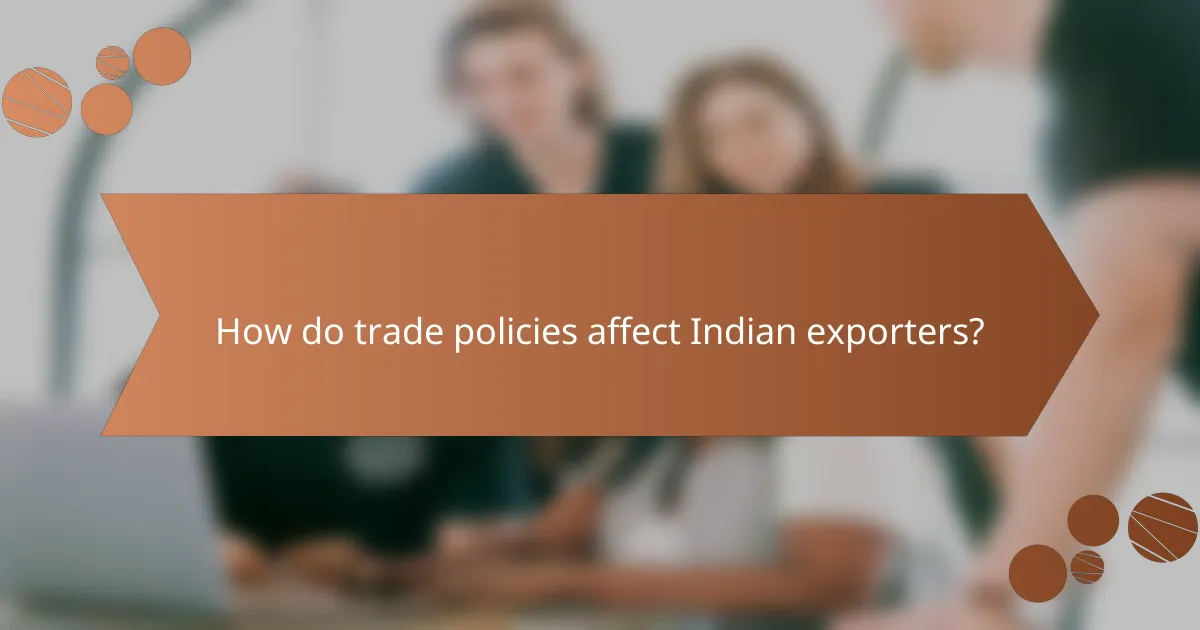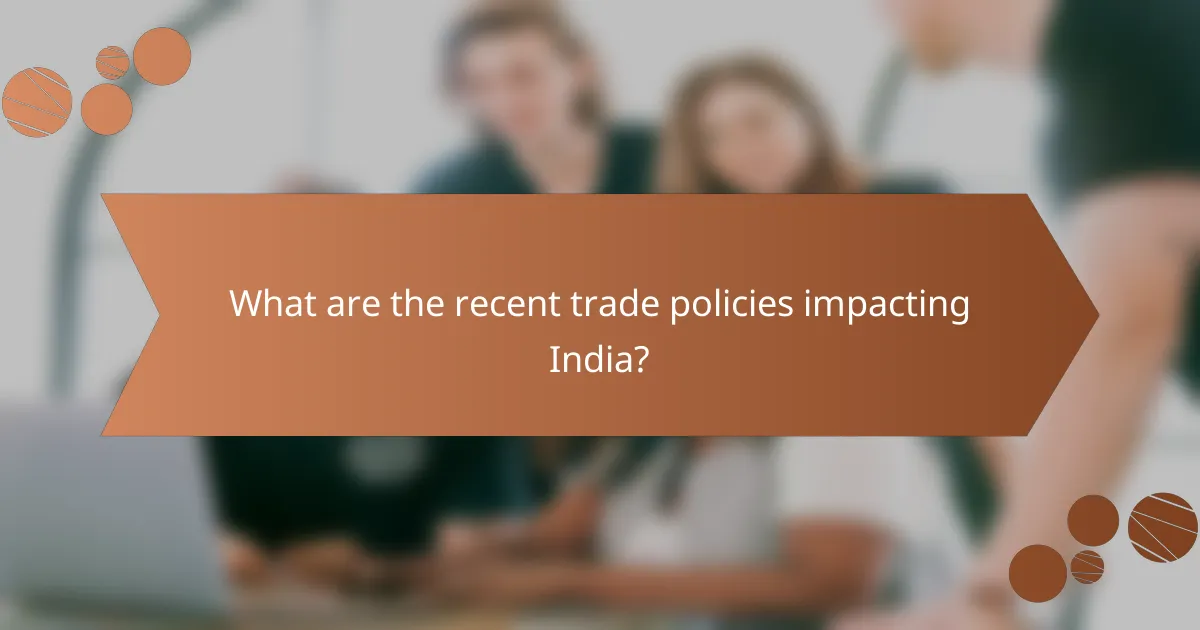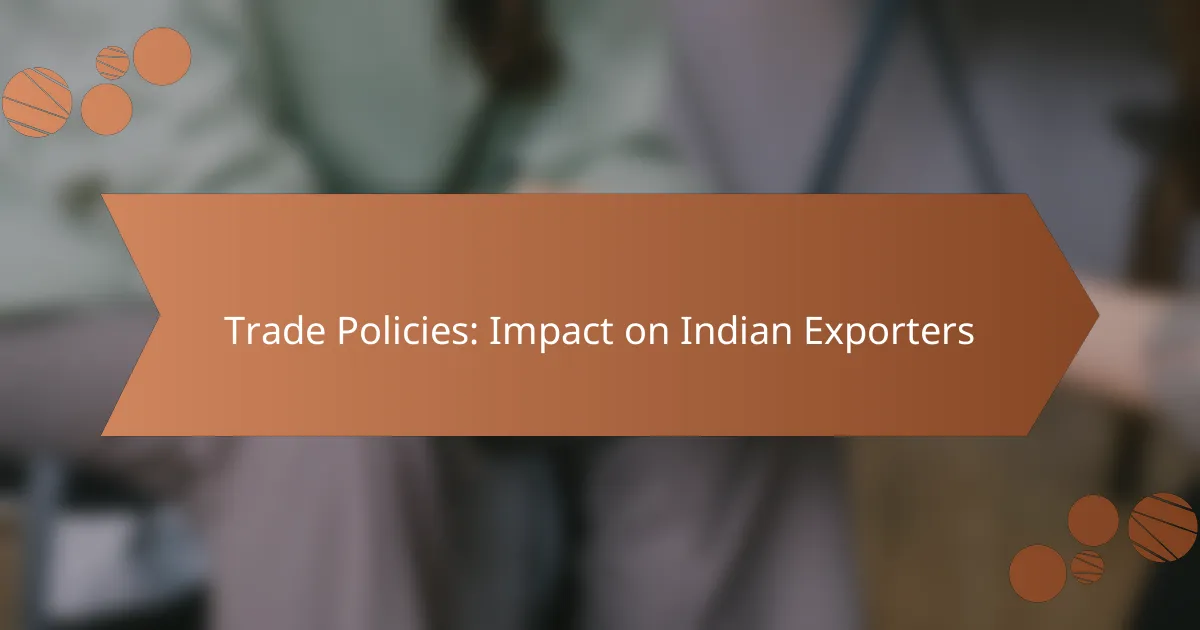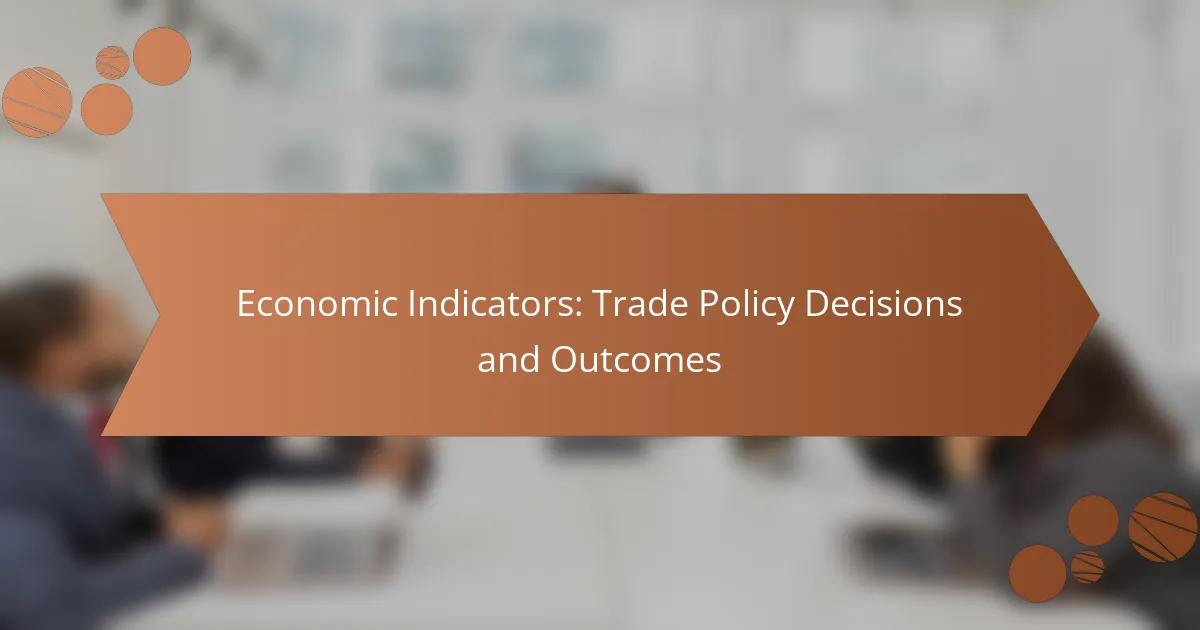Trade policies play a crucial role in shaping the landscape for Indian exporters, affecting their market access, compliance obligations, and pricing strategies. Recent reforms, such as the implementation of the Goods and Services Tax (GST) and updates to Free Trade Agreements (FTAs), aim to enhance export competitiveness, yet challenges like increased tariffs and regulatory hurdles remain significant obstacles in the global marketplace.

How do trade policies affect Indian exporters?
Trade policies significantly influence Indian exporters by determining their access to international markets, compliance requirements, and pricing strategies. Changes in these policies can create opportunities or challenges that directly impact export performance and competitiveness.
Impact on market access
Trade policies shape the market access available to Indian exporters by establishing tariffs, quotas, and trade agreements. Favorable trade agreements can lower tariffs, making Indian goods more competitive in foreign markets, while high tariffs can restrict access and reduce demand.
For instance, India’s participation in regional trade agreements like the South Asian Free Trade Area (SAFTA) has enhanced market access for various goods. Conversely, protectionist measures from other countries can hinder Indian exporters’ ability to penetrate those markets.
Changes in compliance costs
Compliance with trade policies often incurs costs for Indian exporters, including adherence to international standards and regulations. These costs can vary significantly based on the complexity of the regulations and the nature of the goods being exported.
For example, exporters of agricultural products may face stringent phytosanitary standards, leading to increased costs for inspections and certifications. Understanding these compliance requirements is crucial for exporters to avoid penalties and ensure smooth market entry.
Influence on pricing strategies
Trade policies directly affect the pricing strategies of Indian exporters by influencing production costs and competitive positioning. Tariffs can increase the cost of imported raw materials, which may lead exporters to adjust their pricing to maintain margins.
Additionally, exporters must consider the pricing strategies of competitors in markets affected by trade policies. For example, if a competitor benefits from lower tariffs, Indian exporters may need to adopt aggressive pricing strategies to remain competitive.

What are the recent trade policies impacting India?
Recent trade policies in India focus on enhancing export competitiveness and simplifying compliance for exporters. Key reforms include the implementation of Goods and Services Tax (GST) and updates to Free Trade Agreements (FTAs), both of which significantly influence trade dynamics.
Goods and Services Tax (GST) reforms
The GST reforms have streamlined the tax structure for exporters by consolidating multiple indirect taxes into a single tax. This simplification reduces compliance costs and improves cash flow for businesses, allowing them to focus more on production and export activities.
Exporters can benefit from input tax credits under the GST framework, which can offset the tax burden on goods and services used in the production process. However, it is crucial for exporters to maintain accurate records to ensure they can claim these credits effectively.
Free Trade Agreements (FTAs) updates
India has been actively negotiating and updating FTAs to enhance market access for its exporters. These agreements often reduce or eliminate tariffs on a wide range of products, making Indian goods more competitive in foreign markets.
Exporters should stay informed about the specific terms of these FTAs, as they can vary significantly. Understanding the rules of origin and compliance requirements is essential to fully leverage the benefits of these agreements and avoid potential pitfalls.

What challenges do Indian exporters face due to trade policies?
Indian exporters encounter several challenges stemming from trade policies, including increased tariffs and regulatory hurdles in foreign markets. These obstacles can significantly impact their competitiveness and profitability in the global marketplace.
Increased tariffs on key exports
Increased tariffs on key exports can raise the cost of Indian goods in international markets, making them less competitive compared to products from countries with lower tariffs. For instance, if the United States imposes higher tariffs on textiles, Indian textile exporters may see a decline in demand as buyers turn to cheaper alternatives.
Exporters must closely monitor tariff changes and consider adjusting their pricing strategies or exploring alternative markets with more favorable trade agreements. Engaging in trade negotiations or lobbying for tariff reductions can also be beneficial.
Regulatory hurdles in foreign markets
Regulatory hurdles in foreign markets can complicate the export process for Indian businesses. These hurdles may include stringent quality standards, complex documentation requirements, and varying compliance regulations that differ from country to country.
To navigate these challenges, exporters should invest in understanding the specific regulations of their target markets. Collaborating with local partners or hiring compliance experts can streamline the process and reduce the risk of delays or penalties. Additionally, staying updated on international trade agreements can provide insights into easing these regulatory burdens.

What strategies can Indian exporters adopt to navigate trade policies?
Indian exporters can adopt several strategies to effectively navigate trade policies, including diversifying their export markets and investing in compliance training. These approaches help mitigate risks associated with changing regulations and enhance competitiveness in the global market.
Diversification of export markets
Diversifying export markets allows Indian exporters to reduce dependence on any single market, which can be particularly beneficial when trade policies fluctuate. By exploring multiple regions, exporters can identify new opportunities and minimize the impact of adverse regulations in one area.
For instance, Indian textile exporters might consider expanding sales to Southeast Asia, Africa, and Latin America, in addition to their traditional markets in North America and Europe. This strategy not only spreads risk but also helps in understanding varying consumer preferences and regulatory environments.
Investing in compliance training
Investing in compliance training is crucial for Indian exporters to stay updated on the evolving trade policies and regulations in their target markets. Regular training ensures that teams are aware of legal requirements, documentation processes, and best practices for international trade.
Exporters can benefit from workshops and online courses focused on specific regulations such as the Foreign Trade Policy (FTP) in India or the General Agreement on Tariffs and Trade (GATT) principles. This knowledge can prevent costly mistakes and enhance operational efficiency, ultimately leading to smoother export processes.

How can Indian exporters leverage trade agreements?
Indian exporters can leverage trade agreements by taking advantage of reduced tariffs and improved access to foreign markets. These agreements create opportunities for businesses to expand their reach and enhance competitiveness in the global marketplace.
Utilizing preferential tariff rates
Preferential tariff rates allow Indian exporters to benefit from lower customs duties when exporting to countries with which India has trade agreements. This can significantly reduce the cost of goods, making Indian products more attractive in international markets.
Exporters should ensure they meet the specific rules of origin requirements outlined in these agreements to qualify for the preferential rates. For example, they may need to demonstrate that a certain percentage of the product is manufactured in India.
Accessing new markets through FTAs
Free Trade Agreements (FTAs) provide Indian exporters with access to new markets that may have previously been difficult to enter. By eliminating or reducing tariffs, FTAs can open doors to countries in regions like Southeast Asia, the Middle East, and beyond.
Exporters should actively research and identify potential markets that align with their products. Engaging with local trade bodies and participating in trade missions can enhance visibility and facilitate connections in these new markets.

What role do government initiatives play in supporting exporters?
Government initiatives are crucial in supporting exporters by providing resources, incentives, and frameworks that facilitate international trade. These initiatives often include various schemes aimed at enhancing competitiveness, reducing costs, and simplifying processes for exporters.
Export Promotion Schemes
Export promotion schemes are designed to encourage Indian businesses to expand their reach into global markets. These programs may include tax exemptions, duty drawbacks, and incentives for specific sectors, such as textiles or electronics. For example, the Merchandise Exports from India Scheme (MEIS) offers rewards based on export performance, helping exporters reduce their overall expenses.
Additionally, the government often collaborates with industry bodies to identify potential markets and provide training on export processes. This support can significantly enhance the ability of exporters to navigate complex regulations and market dynamics.
Financial assistance programs
Financial assistance programs provide exporters with access to funding options that can alleviate cash flow challenges. These programs may include low-interest loans, grants, and credit guarantees, which help businesses invest in production and marketing for international sales. The Export-Import Bank of India, for instance, offers various financing solutions tailored to the needs of exporters.
Exporters should be aware of the eligibility criteria and application processes for these financial programs. It is advisable to maintain clear financial records and demonstrate a solid export plan to increase the chances of securing funding. Engaging with financial advisors can also help exporters navigate these options effectively.

What are the future trends in trade policies affecting India?
Future trade policies affecting India are likely to focus on sustainability, digitalization, and regional trade agreements. These trends will shape how Indian exporters navigate international markets and adapt to new regulations.
Shift towards digital trade regulations
The shift towards digital trade regulations is transforming how Indian exporters conduct business. Governments are increasingly implementing policies that address e-commerce, data privacy, and cross-border data flows, which are crucial for online transactions.
Indian exporters should be aware of these regulations as they can impact compliance costs and operational efficiencies. For instance, understanding data localization requirements in various countries can help avoid penalties and ensure smoother market entry.
To adapt, businesses should invest in digital infrastructure and stay updated on international standards. Regular training for staff on compliance with digital trade regulations can also mitigate risks associated with non-compliance.



